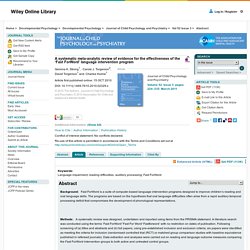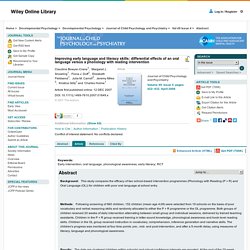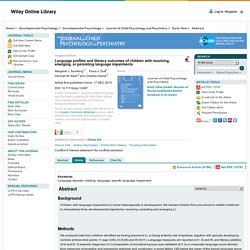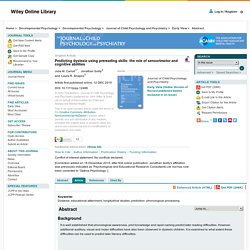

Journal of Child Psychology and Psychiatry. A new symptom model for autism cross-validated in an independent sample - Boomsma - 2008 - Journal of Child Psychology and Psychiatry. A systematic meta-analytic review of evidence for the effectiveness of the ‘Fast ForWord’ language intervention program. Abstract Background: Fast ForWord is a suite of computer-based language intervention programs designed to improve children’s reading and oral language skills.

The programs are based on the hypothesis that oral language difficulties often arise from a rapid auditory temporal processing deficit that compromises the development of phonological representations. Methods: A systematic review was designed, undertaken and reported using items from the PRISMA statement. A literature search was conducted using the terms ‘Fast ForWord’‘Fast For Word’‘Fastforword’ with no restriction on dates of publication. Following screening of (a) titles and abstracts and (b) full papers, using pre-established inclusion and exclusion criteria, six papers were identified as meeting the criteria for inclusion (randomised controlled trial (RCT) or matched group comparison studies with baseline equivalence published in refereed journals). Autistic traits in a population-based ADHD twin sample. Changing concepts of dyslexia: nature, treatment and comorbidity.
Directional effects between rapid auditory processing and phonological awareness in children. Efficacy of small group reading intervention for beginning readers with reading-delay: a randomised controlled trial. Eye-witness memory and suggestibility in children with Asperger syndrome. Improving early language and literacy skills: differential effects of an oral language versus a phonology with reading intervention. Abstract Background: This study compares the efficacy of two school-based intervention programmes (Phonology with Reading (P + R) and Oral Language (OL)) for children with poor oral language at school entry.

Methods: Following screening of 960 children, 152 children (mean age 4;09) were selected from 19 schools on the basis of poor vocabulary and verbal reasoning skills and randomly allocated to either the P + R programme or the OL programme. Both groups of children received 20 weeks of daily intervention alternating between small group and individual sessions, delivered by trained teaching assistants. Children in the P + R group received training in letter-sound knowledge, phonological awareness and book level reading skills. Children in the OL group received instruction in vocabulary, comprehension, inference generation and narrative skills.
Results: The data are clustered (children within schools) and robust confidence intervals are reported. Method Participants. Language profiles and literacy outcomes of children with resolving, emerging, or persisting language impairments. Introduction Language impairment (LI) is a relatively common developmental disorder (Tomblin et al., 1997) which can occur alongside low nonverbal ability (nonspecific language impairment, NLI), or average nonverbal ability (specific language impairment, SLI; Hayiou-Thomas, Oliver, & Plomin, 2005).

Moreover, there is comorbidity between LI and reading disorder/dyslexia (McArthur, Hogben, Edwards, Heath, & Mengler, 2000). Classification of LI, however, is not stable and rates of persistence vary from 11%–92% (Tomblin, Zhang, Buckwalter, & O'Brien, 2003). Practitioner Review: Non-pharmacological treatments for ADHD: A lifespan approach. Predicting dyslexia using prereading skills: the role of sensorimotor and cognitive abilities. Introduction Prospective studies of developmental dyslexia are useful for at least two reasons.

The first is a practical one: they can help to establish which measures would be useful screening tools to predict future difficulties. This could help select children who should be given early support or intervention to try to avoid a negative cycle of attainment (Stanovich, 1986). The second way in which they can be useful is in shedding light on theoretical views of the possible causes of reading difficulties. This paper aims to address both of these issues. Several studies have shown a consistent set of predictors of reading difficulties, including phonological awareness (PA), letter and print knowledge (PK), and rapid naming (Muter, Hulme, Snowling, & Taylor, 1998; Torgesen, Wagner, Rashotte, Burgess, & Hecht, 1997; Wagner et al., 1997). The present study builds on this research in several ways. There is also evidence that subtle visual difficulties could cause reading difficulties.
Pre-literacy skills of subgroups of children with speech sound disorders. Regression and word loss in autistic spectrum disorders. Sensory clusters of toddlers with autism spectrum disorders: differences in affective symptoms. Specific reading disability (dyslexia): what have we learned in the past four decades? The relationship between attention, executive functions and reading domain abilities in attention deficit hyperactivity disorder and reading disorder: a comparative study. Verbal short-term memory span in children: long-term modality dependent effects of intrauterine growth restriction.